Rust Family Foundation: Archaeology Grants Program
Uncovering Commoner Agency and Power through Stone Tool Production at Tamarindito, Petén, Guatemala
Principal Investigator: Phyllis S. Johnson
Department of Anthropology, Vanderbilt University
Importance of the site and project:
Located in the Petexbatun area within the Department of Petén in southwestern Guatemala (fig.1), Tamarindito served as capital of a Classic Maya kingdom from 400-800 C.E. Occupation dating to as early as 300 B.C.E make it one of the oldest political centers in the region. Despite its eventual political dominance, Tamarindito was a relatively small political center until the Late Classic Period.
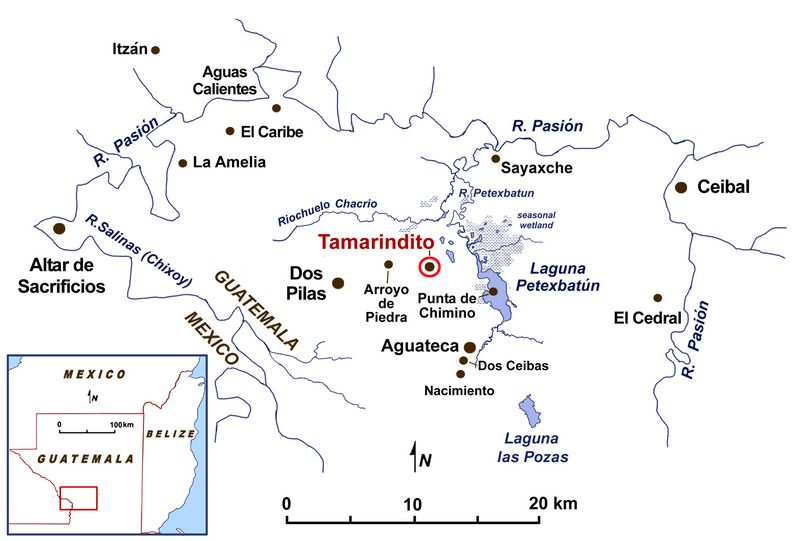
Fig.1: Location of Tamarindito and other Maya sites near Laguna Petexbatun.
.
This project uses excavation, artifact analysis, and artifact density mapping to reveal new information about where Maya commoners manufactured stone tools and the power Maya commoners had over their own economies. Due to archaeology’s past focus in the Maya Lowlands on elite contexts, such as palaces, temples, and elite burials, the study of stone tools has become a focus only in the past few decades. This relative lack of information has left a gap in our understanding of the social, economic, and political relationships between Maya elites and commoners. The present research offers an innovative methodology for filling this gap by introducing the study of microdebitage. Because it represents the first intensive microdebitage study conducted in the Maya lowlands, this research has the potential to transform the way archaeologists use lithic artifacts to explore the role of agency and power among Maya commoners.
Since the late 1970s, archaeologists have increasingly recognized the importance of microartifacts to questions of site structure, site formation processes, site integrity, and identifying activity areas (Ahler 1989; Andrefsky 2007; Baumler and Dowman 1989; Clark 1986; Dunnell and Stein 1989; Hassan 1978; Hull 1983, 1987; Johnson et al. 2016; Metcalfe and Heath 1990; Sherwood 2001; Sherwood and Kocis 2006; Sherwood et al. 1995). Despite the significant contributions that microartifacts provide to our interpretations of the past, these artifacts remain a relatively untapped resource, especially in Mesoamerica, where only a handful of studies utilizing microartifacts have been conducted (Cook et al. 2006; Eberl et al. 2012; Fernandez et al. 2012; Fulton 2015; Kovacevich et al 2010; Mixter and LeCount 2011; Scharlotta et al. 2011). None of these studies in Mesoamerica have explicitly used microdebitage to address stone tools at any scale in Maya society. This project complements archaeological research already in progress at Tamarindito, and will also contribute to archaeological studies in Mesoamerica by incorporating the largest microdebitage study yet completed in the Maya Lowlands and by exploring novel and innovative methodologies for uncovering areas of primary lithic production.
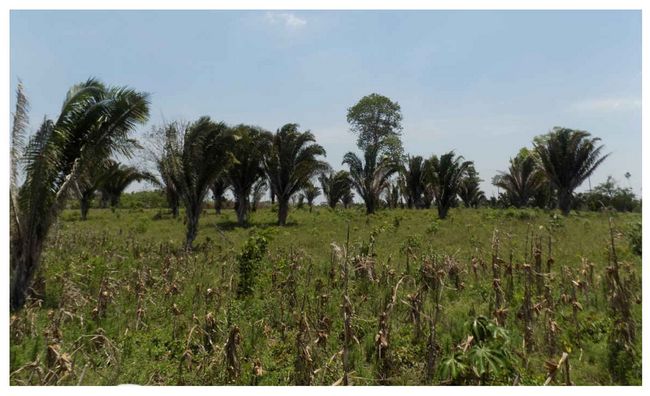
Fig.2: View of hinterland southwest of Plaza B showing deforestation and new growth at Tamarindito.
This work is particularly timely because these and other Maya sites in the Petexbatun region of Guatemala are being heavily threatened by rapid deforestation and looting. According to yearly measurements taken by Markus Eberl, an estimated 80 percent of the rainforest covering Tamarindito has been destroyed since 2009 (personal communication) (fig.2).
Previous Work at the Site:
Tamarindito was first discovered in 1958 and initially investigated by archaeologists in 1960 (Vinson 1960, Grieder 1960). In 1984, site mapping was initiated at the site center, and excavations began in 1990 as part of the Vanderbilt Petexbatun Regional Project (Demarest 2006; O’Mansky 2007). Fieldwork continued through 1994 in the site center and adjacent residential groups (Valdez et al. 1994). Excavations ceased until 2009 with the initiation of the Tamarindito Archaeological Project co-directed by Dr. Markus Eberl of Vanderbilt University and Licda. Claudia Vela of Colegio Evelyn Rogers in Guatemala. This project has focused on the Late and Terminal Classic non-elite residential groups (Eberl 2014; Eberl and Gonzales 2016).
The site includes two main plazas (A and B), situated atop adjacent hills. Plaza A was constructed during the Early Classic period and includes seven plazas with palaces, a temple pyramid, and uncarved panels (Eberl 2014; Eberl and Gonzales 2016). Studies of hieroglyphic inscriptions indicate that Plaza A was the seat of power during the fifth and sixth centuries, while Plaza B, located approximately 400 meters southwest of Group A, became prominent in the Late Classic Period (seventh and eighth centuries) and was likely the seat of the ruling lineage at Tamarindito (Eberl and Gonzales 2016). All residential groups west and southwest of Plaza B were occupied during the Late Classic Period, which represents the height of occupation at Tamarindito.
2017 Funded Research Project (RFF-2017-42):
Goals:
The overall project goals were to:
1) collect soil samples from 25 commoner residential groups,
2) conduct microdebitage analysis to uncover the locations of stone tool production,
3) map the density of microdebitage across the 25 residential groups, and
4) expand access to cultural heritage and archaeological methods to local residents and students.
Although Goals 1 and 4 were achieved, Goals 2 and 3 were not met due to a change in research plan (see Methodologies and Findings). Instead of collecting samples from 25 commoner residential groups, I was able to collect samples from 39 residential groups and four additional elite areas in Plazas A and B.
Methodology:
The proposed research was scheduled to be completed between May-December 2017 in three phases: 1) collection of soil samples in order to recover microdebitage, 2) the analysis of microdebitage in order to determine household stone tool production, and 3) spatial analysis to identify specific areas of stone tool production within and between households. Funding was not requested for spatial analysis (Phase III).
Phase I (Collection of Soil Samples): The initial plan was to collect soil samples from across 25 commoner residential groups in order to compare activities among and between households and residential groups at Tamarindito. The majority of these residential groups are comprised of four residential structures surrounding a central courtyard.
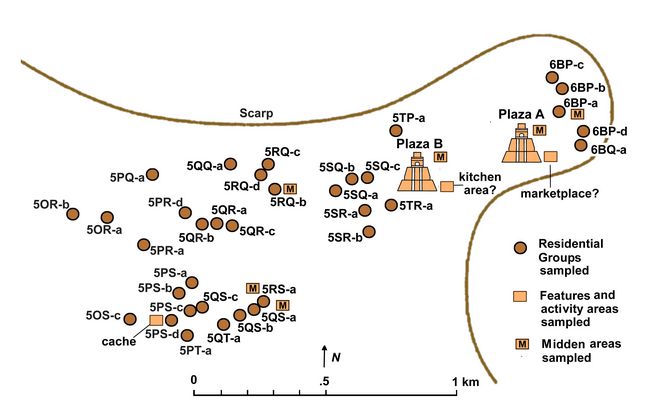
Fig.4: Map of residential groups at Tamarin
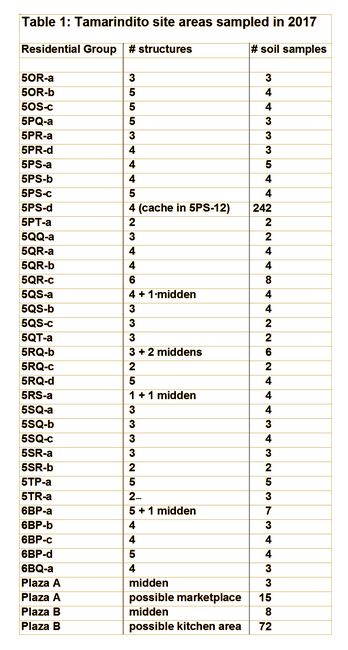 dito (from Eberl and Vela Gonzales 2016).
dito (from Eberl and Vela Gonzales 2016).Once on the ground at Tamarindito, however, I decided to alter the methodology to focus more heavily on the potential lithic workshop at Tamarindito. Since the collection of soil samples went much more quickly than anticipated, we were able to collect 480 soil samples across 39 non-elite residential groups and four elite areas, including a midden and kitchen area associated with Plaza B and a midden and potential marketplace within Plaza A (fig.4 and table 1). Only four of the mapped residential groups were not sampled.
Table 1: Residential groups and elite areas sampled at Tamarindito in 2017.
Samples were collected using posthole diggers in order to take samples that are uniform in diameter. Decisions regarding the locations of soil samples were decided on the ground based on vegetation, location of rubble, and other elements that may have obscured the ground surface. In some cases, obsidian debitage was observed on the ground, and soil samples were taken from near those locations (figs.5+6).
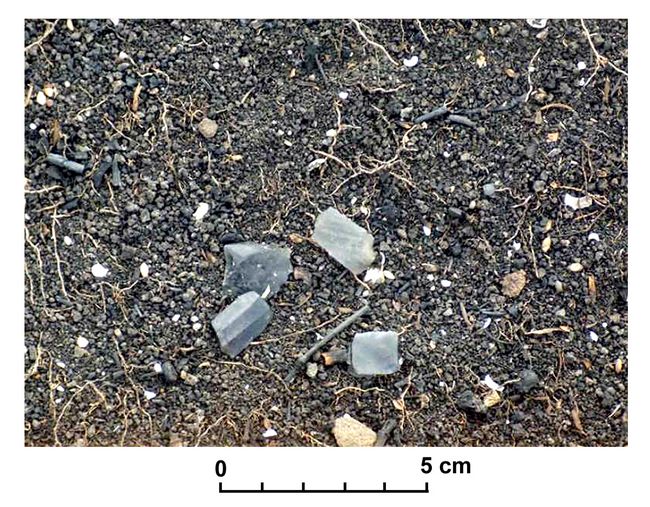
Fig.5: Obsidian blade fragments and debitage on the surface of a midden at Tamarindito
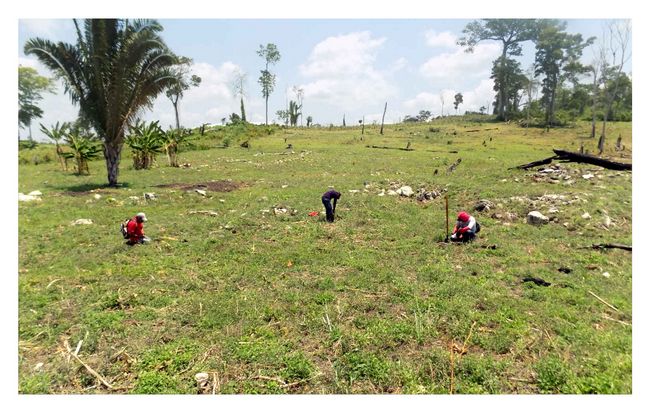
Fig.6: View of field crew taking soil samples at Tamarindito.
Findings
During May 2017, 480 soil samples were collected from 39 non-elite residential groups and four elite areas, including a midden and potential marketplace in Plaza A and a midden and potential kitchen area in Plaza B (fig.4 and table 1). With a large number of samples from both elite and non-elite context of various function, mapping the densities of microdebitage in these locations should provide a more nuanced understanding of stone tool production at Tamarindito.
The largest number of samples were taken from Residential Group 5PS-d (n=242), which had a cache of obisidan artifacts (fig.7), and from two elite areas including a posible marketplace in Plaza A (n=15) and a possible kitchen area in Plaza B (n=72). These three areas are summarized to exemplify the sampling procedures used. Descriptions of these areas include field maps used on the ground at Tamarindito (figs. 7-9). The locations of soil samples are marked by brown dots on each map.
Residential Group 5PS-d: This residential group consists of four structures surrounding a central courtyard. Two
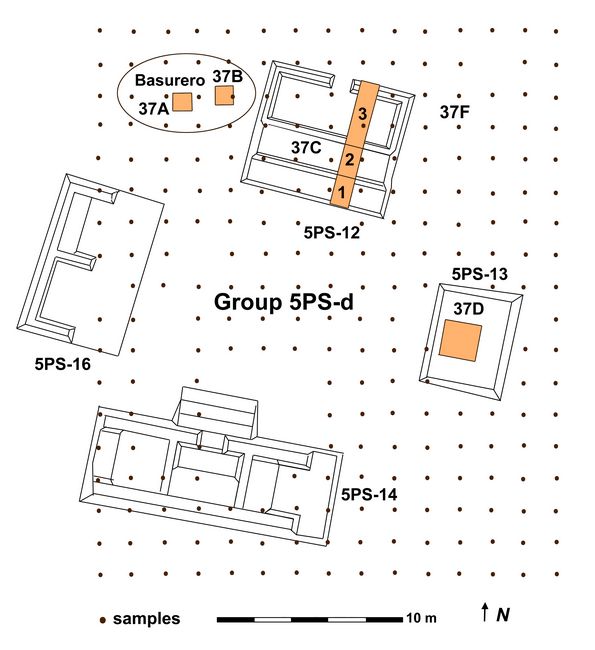 1x1-meter test units, one
2x2-meter test unit, and one 5-meter trench were previously excavated
by the TAP. During TAP excavations, a cache of 12 obsidian cores, 104
obsidian blades, and obsidian debitage were recovered from the
northernmost structure (5PS-12) (Eberl 2014). Because of the potential
for this residential group to contain a lithic workshop, the interval
between soil samples was increased to 2-meter intervals, and a total of
242 soil samples were taken from the central plaza and structures of
this residential group (fig.7).
1x1-meter test units, one
2x2-meter test unit, and one 5-meter trench were previously excavated
by the TAP. During TAP excavations, a cache of 12 obsidian cores, 104
obsidian blades, and obsidian debitage were recovered from the
northernmost structure (5PS-12) (Eberl 2014). Because of the potential
for this residential group to contain a lithic workshop, the interval
between soil samples was increased to 2-meter intervals, and a total of
242 soil samples were taken from the central plaza and structures of
this residential group (fig.7). Fig.7: Map of Residential Group 5PS-d showing locations of soil samples.
Plaza A: In Plaza A, we took samples from two locations: a small possible midden and a potential marketplace. Three soil samples were taken at 5-meter intervals fr
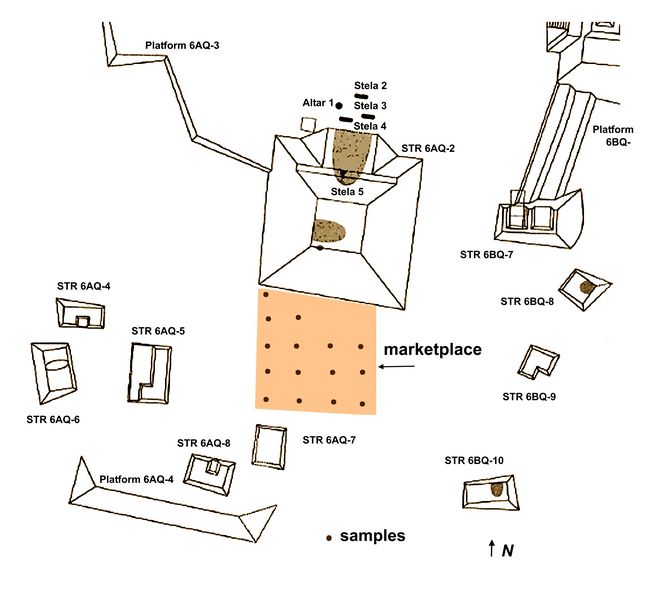 om the possible
midden, which was located on a narrow ledge at the northern edge of
Plaza A. There was not space for more soil samples at this location. An
additional 15 soil samples were taken at 5-meter intervals from a possible marketplace area in the southern portion of Plaza A (fig.8).
om the possible
midden, which was located on a narrow ledge at the northern edge of
Plaza A. There was not space for more soil samples at this location. An
additional 15 soil samples were taken at 5-meter intervals from a possible marketplace area in the southern portion of Plaza A (fig.8).Fig.8: Map of Southern Section of Plaza A, showing location of soil samples from Possible Marketplace.
Plaza B: In Plaza B we took samples from two locations: a midden area and a potential kitchen area. Eight soil samples were taken at
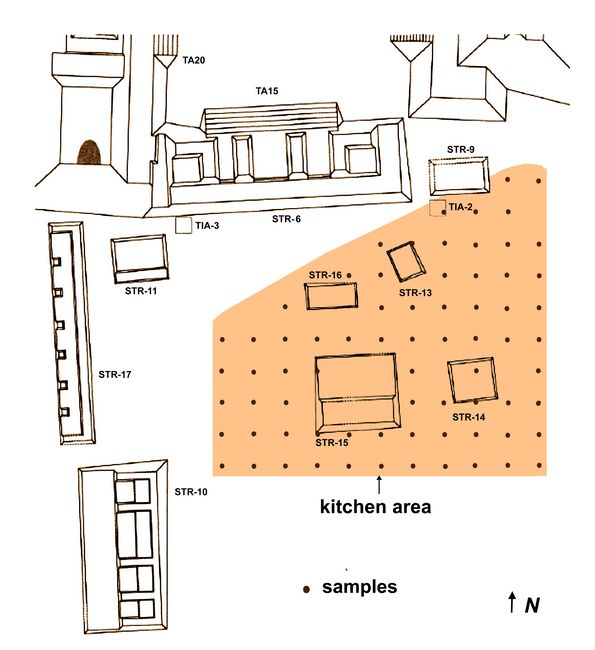 5-meter intervals from the midden area. Dense leaves and
vegetation in the center of the midden prohibited soil samples from
being taken in that area. We also took 72 samples from the potential
kitchen area at 5-meter intervals (fig.9).
5-meter intervals from the midden area. Dense leaves and
vegetation in the center of the midden prohibited soil samples from
being taken in that area. We also took 72 samples from the potential
kitchen area at 5-meter intervals (fig.9). Fig.9: Map of Southern Section of Plaza B, showing location of soil samples from Possible Kitchen Area.
Phase II (Microdebitage Analysis): Once fieldwork was completed at Tamarindito, soil samples to were brought to a temporary lab at Café Yaxha in Flores, Guatemala. There, three local university students from the Universidad de San Carlos de Guatemala assisted in preparing the soil samples for shipment at the end of May, 2017 to Vanderbilt University.
Once at Vanderbilt, all soil samples were fired in a closed oven per USDA guidelines in order to eliminate any biological contaminants. This step took significantly longer than expected, partially because more soil samples were collected than originally anticipated. In order to reach the minimum temperature of 250 degrees (required by the USDA), each sample had to remain in the oven for 40-50 minutes. With four samples in the oven at once, we were able to fire approximately 15-20 samples per day. As such, this step took seven weeks to complete and was finished at the end of July 2017.
Before using flotation analysis to separate microdebitage from the soil matrix (as originally planned), a mechanical shaker was used to mechanically shake each soil sample into separate size grades. This method significantly decreased the amount of time needed to separate soils into size grades. Researchers have determined that microartifacts measuring between 6.4 and 2.0 mm are most useful because these are most resistant to post-depositional movement (Cap 2012; Nielson 1991; Mixter 2016; Mixter and LeCount 2016). As such, all recovered microdebitage will be size-graded using standard geologic screens with graduated sizes of 6.4 mm, 4.0 mm, and 2.0 mm, using the mass analysis technique outlined by Ahler (1989).
Once the material has been processed through the screens, each size grade will be sorted by raw material type. The original plan was to separate microdebitage from natural (versus culturally produced) chert debris based on the assumption that microdebitage generally displays angularity, sharp edges, and flat sides (Dunnell and Stein 1989; Fladmark 1982; Nicholson 1983; Peacock 2004; Peacock et al. 2008). Other diagnostic attributes used to separate out microdebitage have traditionally included transparent or translucent appearance under light, regular geometric shape, and retention of some aspect of conchoidal fracture or bulb of percussion (Fladmark 1982; Nadel 2001; Susino 1999). Because this is an extremely time-intensive process, however, I have since developed a new research plan that will expedite this process.
Phase III (Density Mapping): Results of the microdebitage analysis will be used to create density maps showing the distributions of size classes and material types of microdebitage in order to visualize the spatial distribution of these artifacts. This will ultimately discern areas of stone tool production among residential groups. Because sweeping and trampling embed microartifacts into heavily-used occupation surfaces (such as house floors), microartifacts are less affected by post-depositional processes. As such, this spatial distribution will provide more robust data concerning the organization of stone tool production than those of larger artifacts.
Conclusions:
Although I was not able to complete my project as originally proposed, implementing a new methodology will allow for all 480 soil samples to be analyzed, which will greatly add to the importance and significant of this study for several reasons. First, if successful, this research will constitute the largest microdebitage (and microartifact) study ever completed. As such, the results of this study will demonstrate the significant contribution that microartifacts are capable of making to archaeological research. Second, by discerning activity areas related to stone tool production at both the household and site level, I may be able to detect subtle differences between individual commoner residential groups, which will illuminate the fine-grained social and economic structure of Maya commoners. Furthermore, because I was able to collect soil samples from four elite areas, I will potentially be able to assess differences in stone tool production between elites and non-elites.
Ongoing Plans and Future Research:
For the next phase of my research, I plan to develop a digital machine-learning methodology that will allow for increased accuracy, efficiency, and replicability in microdebitage analysis. As such, this novel methodology will not only improve my own research; it will also expand opportunities for archaeologists to implement microdebitage into their own research.
References:
Ahler, Stanley A.
1989 Mass Analysis of Flaking Debris: Studying the Forest Rather than the Trees. Archeological Papers of the American Anthropological Association, 1: 85–118.
Andrefsky, Jr. William
2007 The Application and Misapplication of Mass Analysis in Lithic Debitage Studies. Journal of Archaeological Science 34:392-402.
Aoyama, Kazuo
2007 Elite Craft Producers, Artists, and Warriors at Aguateca: Lithic Analysis. Monographs of the Aguateca Archaeological Project First Phase, ed. by T. Inomata and D. Triadan.
Baumler, Mark F. and Charles E. Downum
1989 Between Micro and Macro: A Study of the Interpretation of Small-Sized Lithic Debitage. In Experiments in Lithic Technology, edited by D.S. Amick, and R.P. Mauldin, pp. 101-116. BAR International Series 528. British Archaeological Reports, Oxford.
Cap, Bernadette
2015 Classic Maya Economies: Identification of a Marketplace at Buenavista del Cayo, Belize. Unpublished Ph. D Dissertation. University of Wisconsin-Madison.
Clark, J. E.
1986 Another Look at Small Debitage and Microdebitage, Lithic Technology 15:21–33.
Cook, Duncan, E., Brigitte Kovacevich, Timothy Beach, Ronald Bishop
2006 Deciphering the Inorganic Chemical Record of Ancient Human Activity using ICP-MS: a Reconnaissance Study of Late Classic Soil Floors at Cancuen, Guatemala. Journal of Archaeological Science 33:628-640.
Demarest, Arthur A.
2006 The Petexbatun Regional Archaeological Project: A Multidisciplinary Study of the Maya Collapse. Vanderbilt University Press.
Dobres, Marcia-Anne and John E. Robb
2000 Agency in Archaeology. Routledge, Oxford.
Dunnell, Richard C. and Julie K. Stein
1989 Theoretical Issues in the Interpretation of Microartifacts. Geoarchaeology: An International Journal, 4:31-32.
Eberl, Markus, Marco Alvarez, and Richard E. Terry
2012 Chemical Signatures of Middens at a Late Classic Maya Residential Complex, Guatemala. Geoarchaeology 27(5):426-440.
Eberl, Markus and Claudia Marie Vela Gonzalez
2016 Entre Reyes y Campesinos: Investigaciones arqueologicas en la Antigua Capital Maya de Tamarindito. Paris Monographs in American Archaeology. Archaeopress Access Archaeology.
Fernández, Fabián G., Richard E. Terry, Takeshi Inomata, and Markus Eberl
2002 An Ethnoarchaeological Study of Chemical Residues in the Floors and Soils of Q'eqchi' Maya Houses at Las Pozas, Guatemala. Geoarchaeology 17(6):487-519.
Fladmark, Knut. R.
1982 Microdebitage Analysis: Initial Consideration. Journal of Archaeological Science 9(2):205-20.
Foias, Antonia
1996 Changing Ceramic Production and Exchange and the Classic Maya Collapse in the Petexbatun Region. Ph.D. dissertation. Nashville: Department of Anthropology, Vanderbilt University.
Fulton, Kara A.
2015 Community Identity and Social Practice during the Terminal Classic Period at Actuncan, Belize. Unpublished Ph. D Dissertation, University of South Florida.
Grieder, Terence
1960 Manifestaciones de Arte Maya en la Región de Petexbatun. Antropología e Historia de Guatemala 12(2):10-24.
Hassan, F.A.
1978 Sediments in Archaeology: Methods and Applications for Paleoenvironmental and Cultural Analysis. Journal of Field Archaeology 5(2): 197-213.
Homsey-Messer, Lara and Anthony Ortmann
2016 Microartifact Analysis: Recent Applications in Southeastern Archaeology. Southeastern Archaeology 35(1):1-7.
Homsey-Messer, Lara, Anthony Ortmann, Lori Roe, and Howard Cyr
2016 Taphonomy and the Role of Experimentation in Microartifact Analysis. Southeastern Archaeology 35(1):65-69.
Hull, Kathleen L.
1983 Application of Microdebitage Analysis to Examination of Spatial Patterning. MA Thesis, Department of Archaeology, University of Calgary.
1987 Identification of Cultural Site Formation Processes through Microdebitage Analysis. American Antiquity 52(4):772-783.
Inomata, Takeshi, and Laura Stiver
1998 Floor Assemblages from Burned Structures at Aguateca, Guatemala: A Study of Classic Maya Households. Journal of Field Archaeology 25:431-452.
Johnson, Phyllis S., James C. Pritchard, and Eric C. Poplin
2016 In Much Smaller Things Forgotten: a Case for Microartifact Analysis in Cultural Resource Management. Southeastern Archaeology 35(1):38-50.
Kovacevich, Brigitte, Molly Morgan, Hector Neff, and Oswaldo Chinchilla
2010 The Use of Laser Ablation Inductively Coupled Plasma Mass Spectrometry (LA-ICP MS) on Obsidian Microdebitage: Case Studies from Chiquiuitan and El Baúl, Guatemala. Society for Archaeological Sciences Bulletin 33(1): 2-6.
Levine, Marc N.
2014 Reflections of Obsidian Studies in Mesoamerica: Past, Present, and Future. In Obsidian Reflections: Symbolic Dimensions of Obsidian in Mesoamerica, edited by Marc N. Levine and David Carballo. University Press of Colorado.
Metcalfe, D., Heath, K.M.,
1990 Microrefuse and Site Structure: the Hearths and Floors of the Heartbreak Hotel. American Antiquity 55:781–796.
Mixter, D. W., T. Jamison, and L. J. LeCount.
2011 Activity under a Microscope: Microartifact Analysis of Two Elite Complexes at Actuncan, Belize. Paper presented at the 76th Annual Meeting of the Society for American Archaeology, Sacramento, California.
Moholy-Nagy, Hattula
1990 The Misidentification of Mesoamerican Lithic Workshops. Latin American Antiquity 1(3):268-279.
Nadel, D.
2001 Indoor/Outdoor Flintknapping and Minute Debitage Remains: The Evidence from the Ohalo II Submerged Camp (19.5 KY, Jordan Valley). Lithic Technology 26(2):118-137.
Nicholson, Bev A.
1983 A Comparative Evaluation of Four Sampling Techniques and of the Reliability of Microdebitage as a Cultural Indicator in Regional Surveys. Plains Anthropologist 28(2.1):273-281.
Nielsen, Axel E.
1991 Trampling the Archaeological Record: an Experimental Study. American Antiquity 56(3):483-503.
O’Mansky, Matt
2007 The Petexbatun Intersite Settlement Pattern Survey: Shifting Settlement Strategies in the Ancient Maya World. Unpublished Ph. D Dissertation. Vanderbilt University.
Peacock, Evan
2004 Using Macro- and Microartifacts to Investigate the Function and Duration of Short-term Prehistoric Sites: An Example from North Mississippi. Mississippi Archaeology 39:3-24.
Peacock, Evan, Stephen M. Davis, and Timothy M. Ryan
2008 Microdebitage Analysis at the Pinnix Site (22GR795) in Grenada County, Mississippi. Mississippi Archaeology 43(1):49-66.
Scharlotta, Ian, William Gilstrap, and Hector Neff
2011 No Stone Unburned: A Compositional Analysis of Obsidian Microdebitage by Laser Ablation TOF–ICP–MS. Archaeometry 53(5):873-889.
Sherwood, Sarah C.
2001 Microartifacts. In Earth Science and Archaeology, edited by Paul Goldberg, Vance T. Holliday and C. Reid Ferring. Kluwer Academic/Plenum Publishers New York.
2006 Deep Testing Methods in Alluvial Environments: Coring vs. Trenching on the Nolichucky River. Tennessee Archaeology 2(2):107-119.
Sherwood, Sarah C., Jan F. Simek, and Richard H. Polhemus
1995a Artifact Size and Spatial Process: Macro- and Microartifacts in a Mississippian House. Geoarchaeology: An International Journal 10(6):429-455.
Susino, George J.
1999 Microdebitage and the Archaeology of Rock Art: An Experimental Approach. Unpublished Master’s Thesis, Division of Geography, University of Sydney, Australia.
Tourtellot, Gair, Ill, Jeremy A. Sabloff, and Kelli Carmean
1992 Will the Real Elites Please Stand Up: An Archaeological Assessment of Maya Elite Behavior in the Terminal Classic Period. In Mesoamerican Elites: An Archaeological Assessment, edited by D.Z. Chase and A.F. Chase, University of Oklahoma Press, Norman, OK, pp. 80.
Ullah, Isaac I. T., Paul R. Duffy, and E. B. Banning
2015 Modernizing Spatial Micro-Refuse Analysis: New Methods for Collecting, Analyzing, and Interpreting the Spatial Patterning of Micro-Refuse from House-Floor Contexts. Journal of Archaeological Method and Theory 22(4):1238-62.
Valdés, Juan Antonio, Antonia Foias, and Oswaldo Chinchilla
1994 Tamarindito: un Sitio con Historia en la Región de Petexbatun. VII Simposio de Investigaciones Arqueológicas en Guatemala, 1993, edited by Juan Pedro Laporte and Héctor Escobedo, pp. 368-380. Guatemala City: Ministerio de Cultura y Deportes, IDAEH, Asociación Tikal.
Vinson, George
1960 Two Important Recent Archaeological Discoveries in Esso Concessions, Guatemala. Standard Oil Company Exploration Newsletter (March): 114-122.
Recent Foundation grants: general Archaeology Grants Program w/map
Copyright © 2018 Rust Family Foundation